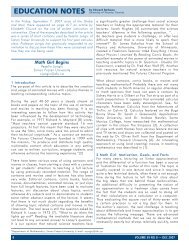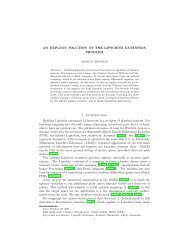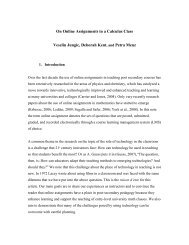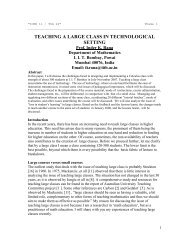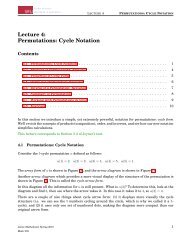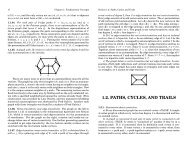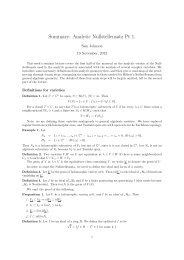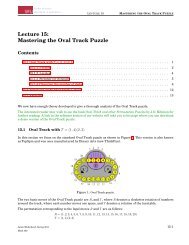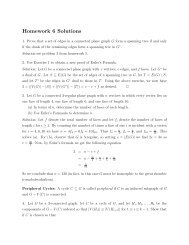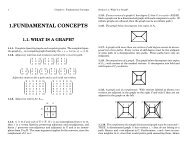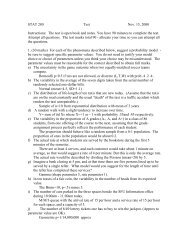The Orbit-Stabilizer Theorem - People.stat.sfu.ca
The Orbit-Stabilizer Theorem - People.stat.sfu.ca
The Orbit-Stabilizer Theorem - People.stat.sfu.ca
You also want an ePaper? Increase the reach of your titles
YUMPU automatically turns print PDFs into web optimized ePapers that Google loves.
Week Date Sections<br />
from FS2009<br />
Part/ References Topic/Sections Notes/Speaker<br />
1 Sept 7 I.1, I.2, I.3 Combinatorial Symbolic methods<br />
2 14 I.4, I.5, I.6<br />
Structures<br />
FS: Part A.1, A.2<br />
Unlabelled structures<br />
3 21 II.1, II.2, II.3<br />
Comtet74<br />
Handout #1<br />
Labelled structures I<br />
4 28 II.4, II.5, II.6<br />
(self study)<br />
Labelled structures II<br />
5 Oct 5 III.1, III.2<br />
Combinatorial<br />
parameters<br />
FS A.III<br />
(self-study)<br />
Combinatorial<br />
Parameters<br />
6 12 IV.1, IV.2 Multivariable GFs<br />
Asst #1 Due<br />
7 19 IV.3, IV.4 Analytic Methods Complex Analysis<br />
8<br />
9<br />
26<br />
Nov 2<br />
IV.5 V.1<br />
FS: Part B: IV, V, VI<br />
Appendix B4<br />
Stanley 99: Ch. 6<br />
Handout #1<br />
Singularity Analysis<br />
Asymptotic methods<br />
Asst #2 Due<br />
10<br />
9 VI.1<br />
(self-study)<br />
Sophie<br />
12 A.3/ C<br />
Introduction to Prob. Mariolys<br />
11<br />
12<br />
f aculty of science MATH 895-4 Fall 2010<br />
department of mathematics Course Schedule<br />
LECTURE 22 ORBIT-STABILIZER THEOREM<br />
Lecture 22:<br />
Symmetry & Counting I:<br />
<strong>The</strong> <strong>Orbit</strong>-<strong>Stabilizer</strong> <strong>The</strong>orem<br />
Contents<br />
22.1 <strong>Orbit</strong>s & Stablizers . . . . . . . . . . . . . . . . . . . . . . . . . . . . . . . . . . . . . . . . . . . . . . 1<br />
22.2 Permutations Acting on Sets: Appli<strong>ca</strong>tion of the <strong>Orbit</strong>-<strong>Stabilizer</strong> <strong>The</strong>orem . . . . . . . . . . . . . . 5<br />
22.2.1 Rotation Group of a Tetrahedron . . . . . . . . . . . . . . . . . . . . . . . . . . . . . . . . . . 5<br />
22.2.2 Rotation Group of a Cube . . . . . . . . . . . . . . . . . . . . . . . . . . . . . . . . . . . . . . 5<br />
18 IX.1 Limit Laws and Comb Marni<br />
20 IX.2 Random Structures<br />
and Limit Laws<br />
Discrete Limit Laws Sophie<br />
23 IX.3<br />
FS: Part C<br />
(rotating<br />
presentations)<br />
Combinatorial<br />
instances of discrete<br />
Mariolys<br />
25 IX.4 Continuous Limit Laws Marni<br />
22.2.3 Rotation Group of an Octahedron . . . . . . . . . . . . . . . . . . . . . . . . . . . . . . . . . . 7<br />
22.2.4 Rotation Group of an Dode<strong>ca</strong>hedron . . . . . . . . . . . . . . . . . . . . . . . . . . . . . . . . 7<br />
22.2.5 Rotation Group of an Icosahedron . . . . . . . . . . . . . . . . . . . . . . . . . . . . . . . . . 8<br />
Quasi-Powers and<br />
13 30 22.2.6 IX.5 Rotation Group of an Soccer Sophie<br />
Gaussian Ball, limit laws Basket Ball, Volley Ball, and Tennis Ball . . . . . . . . . 9<br />
22.3 Exercises . . . . . . . . . . . . . . . . . . . . . . . . . . . . . . . . . . . . . . . . . . . . . . . . . . . . 11<br />
14 Dec 10 Presentations Asst #3 Due<br />
In this lecture we discuss how to use group theory to count like a professional: we look at an appli<strong>ca</strong>tion of<br />
cosets to determine the size of a permutation group. In particular, we discover a straightforward way to count<br />
the number of symmetries of various geometric objects.<br />
22.1 <strong>Orbit</strong>s & Stablizers<br />
Dr. Marni MISHNA, Department of Mathematics, SIMON FRASER UNIVERSITY<br />
Version of: 11-Dec-09<br />
In this section we will take a look at how permutation groups act on various structures.<br />
It will be helpful to extend the definition of a permutation from finite sets of numbers Zn, to arbitrary sets.<br />
Let X be a nonempty set. A permutation α of X is a bijection α : X → X. <strong>The</strong> set of all permutations of X is<br />
<strong>ca</strong>lled the symmetric group of X and is denoted by SX:<br />
SX = {α | α : X → X is a bijection}.<br />
If X = Zn = {1, 2, . . . , n} then we simply denoted SZn by Sn.<br />
Definition 22.1 (<strong>Stabilizer</strong> of a Point) Let G be a subgroup of SX. For each i ∈ X, let<br />
We <strong>ca</strong>ll stabG(i) the stabilizer of i in G.<br />
stabG(i) = {α ∈ G | α(i) = i}.<br />
We <strong>ca</strong>n check that stabG(i) is a subgroup of G. Since ε fixes every element in X it is definitely in stabG(i). Let<br />
α, β ∈ G, then α(i) = i and β(i) = i. It then follows that α −1 (i) = i and (αβ)(i) = β(α(i)) = β(i) = i, hence<br />
α −1 , αβ ∈ stabG(i). <strong>The</strong>refore stabG(i) < G.<br />
Jamie Mulholland, Spring 2011<br />
Math 302<br />
22-1
Week Date Sections<br />
from FS2009<br />
Part/ References Topic/Sections Notes/Speaker<br />
1 Sept 7 I.1, I.2, I.3 Combinatorial Symbolic methods<br />
2 14 I.4, I.5, I.6<br />
Structures<br />
FS: Part A.1, A.2<br />
Unlabelled structures<br />
3 21 II.1, II.2, II.3<br />
Comtet74<br />
Handout #1<br />
Labelled structures I<br />
4 28 II.4, II.5, II.6<br />
(self study)<br />
Labelled structures II<br />
5 Oct 5 III.1, III.2<br />
Combinatorial<br />
parameters<br />
FS A.III<br />
Combinatorial<br />
Parameters<br />
6 12 IV.1, IV.2 (self-study)<br />
Multivariable GFs<br />
Asst #1 Due<br />
7 19 IV.3, IV.4 Analytic Methods Complex Analysis<br />
8<br />
9<br />
26<br />
Nov 2<br />
IV.5 V.1<br />
FS: Part B: IV, V, VI<br />
Appendix B4<br />
Stanley 99: Ch. 6<br />
Handout #1<br />
Singularity = S Analysis<br />
{1,2,4}.<br />
Asymptotic methods<br />
Asst #2 Due<br />
10<br />
9 VI.1<br />
(self-study)<br />
Sophie<br />
12 A.3/ C<br />
Introduction to Prob. Mariolys<br />
11<br />
18<br />
20<br />
IX.1 Limit Laws and Comb<br />
G = 〈(1, 2, 3)(4, 5, 6)(7, 8)〉<br />
IX.2 Random Structures Discrete Limit Laws<br />
and Limit Laws<br />
Marni<br />
Sophie<br />
FS: Part C<br />
Combinatorial<br />
23 IX.3<br />
Mariolys<br />
(rotating<br />
12<br />
instances of discrete<br />
be a group of permutation presentations) on X = {1, 2, 3, 4, 5, 6, 7, 8}. <strong>The</strong>n<br />
25 IX.4 Continuous Limit Laws Marni<br />
13 30 IX.5<br />
f aculty of science MATH 895-4 Fall 2010<br />
department of mathematics Course Schedule<br />
LECTURE 22 ORBIT-STABILIZER THEOREM<br />
Definition 22.2 (<strong>Orbit</strong> of a Point) Let G be a subgroup of SX. For each i ∈ X, let<br />
We <strong>ca</strong>ll orbG(i) the orbit of i under G.<br />
14 Dec 10 Presentations Asst #3 Due<br />
Dr. Marni MISHNA, Department of Mathematics, SIMON FRASER UNIVERSITY<br />
Version of: 11-Dec-09<br />
orbG(i) = {α(i) | α ∈ G}.<br />
Example 22.1 If G = S4, then stabS4 (3) is the set of all permutation in S4 which fixes 3. <strong>The</strong>re are 4! = 24<br />
permutations in S4 but only the ones that don’t have 3 in their disjoint cycle form fix 3. <strong>The</strong>refore,<br />
stabS4(3) = {ε, (1, 2), (1, 4), (2, 4), (1, 2, 4), (1, 4, 2)}<br />
Notice we used the notation S {1,2,4} to denote the set of all permutations of the set {1, 2, 4}.<br />
Example 22.2 Let<br />
= {ε, (1, 2, 3)(4, 5, 6)(7, 8), (1, 3, 2)(4, 6, 5), (7, 8), (1, 2, 3)(4, 5, 6), (1, 3, 2)(4, 6, 5)(7, 8)}.<br />
orbG(1) = {1, 2, 3}<br />
orbG(2) = {2, 3, 1}<br />
Quasi-Powers stabG(1) and = {ε, (7, 8)}<br />
Sophie<br />
Gaussian limit laws<br />
stabG(2) = {ε, (7, 8)}<br />
orbG(3) = {3, 1, 2} stabG(3) = {ε, (7, 8)}<br />
orbG(4) = {4, 5, 6} stabG(4) = {ε, (7, 8)}<br />
orbG(5) = {5, 6, 4} stabG(5) = {ε, (7, 8)}<br />
orbG(6) = {6, 4, 5} stabG(6) = {ε, (7, 8)}<br />
orbG(7) = {7, 8} stabG(7) = {ε, (1, 2, 3)(4, 5, 6), (1, 3, 2)(4, 6, 5)}<br />
orbG(8) = {8, 7} stabG(8) = {ε, (1, 2, 3)(4, 5, 6), (1, 3, 2)(4, 6, 5)}<br />
In each <strong>ca</strong>se notice that stabG(i) is a subgroup of G. Also notice that orbits are either disjoint or equal. Moreover,<br />
the distinct orbits:<br />
{1, 2, 3}, {4, 5, 6}, {7, 8}<br />
form a partition of X.<br />
Let G be a group of permutations on X, and define a relation on X by:<br />
x ∼G y ⇐⇒ y = α(x) for some α ∈ G. (1)<br />
<strong>The</strong>n ∼G is an equivalence relation (see Exercise 1), and the equivalence class of an element x ∈ X is its orbit:<br />
[x] = orbG(x).<br />
Since equivalence classes partition the set, this indi<strong>ca</strong>tes that our observation in Example 22.2 were not coincidence.<br />
<strong>Orbit</strong>s will always be the same or disjoint, and distinct orbit classes will partition X.<br />
Example 22.3 Re<strong>ca</strong>ll that D4, the dihedral group of the square, is the group of all symmetries of the square<br />
(see Figure 1a). <strong>The</strong> elements are the rotations R0, R90, R180, R270, and the reflections H, V, D, D ′ . We <strong>ca</strong>n view<br />
D4 as a group of permutations on the vertices of the square. Here we identify the vertices of the square with the<br />
set X = {1, 2, 3, 4}. See Figure 1b. Since vertex 1 <strong>ca</strong>n be taken to any other vertex by a rotation then the orbit of<br />
1 is all of X: orbD4 (1) = {1, 2, 3, 4}.<br />
<strong>The</strong> stabilizer of 1 is:<br />
Similarly, we have stabD4(2) = stabD4(3) = {R0, D ′ }.<br />
Jamie Mulholland, Spring 2011<br />
Math 302<br />
stabD4 (1) = {R0, D}.<br />
22-2
Week Date Sections<br />
from FS2009<br />
Part/ References Topic/Sections Notes/Speaker<br />
1 Sept 7 I.1, I.2, I.3 Combinatorial Symbolic methods<br />
2 14 I.4, I.5, I.6<br />
Structures<br />
FS: Part A.1, A.2<br />
Unlabelled structures<br />
3 21 II.1, II.2, II.3<br />
Comtet74<br />
Handout #1<br />
Labelled structures I<br />
4 28 II.4, II.5, II.6<br />
(self study)<br />
Labelled structures II<br />
5 Oct 5 III.1, III.2<br />
Combinatorial<br />
parameters<br />
FS A.III<br />
(self-study)<br />
Combinatorial<br />
Parameters<br />
Asst #1 Due<br />
6 12 IV.1, IV.2 Multivariable GFs<br />
7 19 IV.3, IV.4<br />
(a) Reflection elements in D4<br />
Analytic Methods Complex Analysis<br />
8<br />
9<br />
26<br />
Nov 2<br />
IV.5 V.1<br />
FS: Part B: IV, V, VI<br />
Appendix B4<br />
Stanley 99: Ch. 6<br />
Handout #1<br />
Singularity Analysis<br />
Asymptotic methods<br />
Asst #2 Due<br />
10<br />
9 VI.1<br />
(self-study)<br />
Sophie<br />
12 A.3/ C<br />
Introduction to Prob. Mariolys<br />
11<br />
12<br />
f aculty of science MATH 895-4 Fall 2010<br />
department of mathematics Course Schedule<br />
LECTURE 22 ORBIT-STABILIZER THEOREM<br />
18 IX.1 Limit Laws and Comb Marni<br />
20 IX.2 Random Structures<br />
and Limit Laws<br />
Discrete Limit Laws Sophie<br />
23 IX.3<br />
FS: Part C<br />
(rotating<br />
presentations)<br />
Combinatorial<br />
instances of discrete<br />
Mariolys<br />
25 IX.4 Continuous Limit Laws Marni<br />
13 30 IX.5<br />
Quasi-Powers and<br />
(a) <strong>Orbit</strong> of point P under Gaussian ac- limit laws<br />
Sophie<br />
14 Dec 10<br />
tion of D4<br />
Presentations Asst #3 Due<br />
Dr. Marni MISHNA, Department of Mathematics, SIMON FRASER UNIVERSITY<br />
Version of: 11-Dec-09 orbD4(h) = {h, v} stabD4(h) = {R0, R180, H, V }<br />
orbD4(v) = {h, v} stabD4(v) = {R0, R180, H, V }<br />
orbD4 (d) = {d, d′ } stabD4 (d) = {R0, R180, D, D ′ }<br />
orbD4 (d′ ) = {d, d ′ } stabD4 (d′ ) = {R0, R180, D, D ′ }<br />
(b) <strong>Orbit</strong> of vertex 1<br />
Figure 1: <strong>The</strong> group D4 acting as a permutation group on the set of vertices.<br />
(b) <strong>Orbit</strong> of point Q under action<br />
of D4<br />
Figure 2: <strong>The</strong> group D4 acting as a permutation group on the set of points enclosed by the square.<br />
Example 22.4 Building on the previous example, we may view D4 as a group of permutations of the points X<br />
enclosed by the square. Figure 2a illustrates the orbit of the point P and Figure 2b illustrates the orbit of the<br />
point Q under D4. Notice stabD4 (P ) = {R0, D}, and stabD4 (Q) = {R0}.<br />
We <strong>ca</strong>n also view D as a group of permutations on the set of 4 line segments h, v, d, d ′ shown in Figure 3. <strong>The</strong>n<br />
Figure 3: <strong>Orbit</strong> classes of the group D4 acting as a permutation group on the set of line segments h, v, d, d ′ .<br />
Example 22.5 Let RC3 be the Rubik’s cube group, and let X be the set of all cubies of Rubik’s cube. X <strong>ca</strong>n be<br />
partitioned into edge cubies E, corner cubies V , and centre cubies C. If x denotes the uf edge cubie, then since it<br />
is possible to move it to the lo<strong>ca</strong>tion of any other edge cubie, then orbRC3 (x) = E. Also, since centre cubies don’t<br />
move under cube moves, the orbit of each centre cubie is just a set of size 1.<br />
Jamie Mulholland, Spring 2011<br />
Math 302<br />
22-3
Week Date Sections<br />
from FS2009<br />
Part/ References Topic/Sections Notes/Speaker<br />
5 Oct 5 III.1, III.2<br />
Combinatorial<br />
parameters<br />
FS A.III<br />
Combinatorial<br />
Parameters<br />
6 12 IV.1, IV.2 (self-study)<br />
Multivariable GFs<br />
Asst #1 Due<br />
7 19 IV.3, IV.4 Analytic Methods Complex Analysis<br />
8<br />
9<br />
26<br />
Nov 2<br />
IV.5 V.1<br />
FS: Part B: IV, V, VI<br />
Appendix B4<br />
Stanley 99: Ch. 6<br />
Handout #1<br />
Singularity Analysis<br />
Asymptotic methods<br />
Asst #2 Due<br />
10<br />
9 VI.1<br />
(self-study)<br />
Sophie<br />
12 A.3/ C<br />
Introduction to Prob. Mariolys<br />
11<br />
18 IX.1 Limit Laws and Comb Marni<br />
20 IX.2 Random Structures<br />
and Limit Laws<br />
Discrete Limit Laws Sophie<br />
23 IX.3<br />
FS: Part C<br />
(rotating<br />
presentations)<br />
Combinatorial<br />
instances of discrete<br />
Mariolys<br />
25 IX.4 Continuous Limit Laws Marni<br />
13 30 IX.5<br />
f aculty of science MATH 895-4 Fall 2010<br />
department of mathematics Course Schedule<br />
LECTURE 22 ORBIT-STABILIZER THEOREM<br />
Example 22.6 Again, let RC3 be the Rubik’s cube group, but now let X be the set of all facets of Rubik’s cube.<br />
Re<strong>ca</strong>ll 1 Sept |X| 7 = I.1, 48. I.2, I.3 <strong>The</strong> Rubik’s cube group<br />
Combinatorial Symbolic <strong>ca</strong>nmethods be viewed as a group of permutations of the set X (we have made<br />
use of this fact frequently Structures already). Let x be the facet on the up layer of the uf cubie. In our numbering system<br />
2 14 I.4, I.5, I.6 Unlabelled structures<br />
we denoted this facet by FS: Part x = A.1, 7. A.2Since<br />
an edge cubie <strong>ca</strong>n be moved to the lo<strong>ca</strong>tion of any other edge cubie, and<br />
Comtet74<br />
3 21 II.1, II.2, II.3 Labelled structures I<br />
with either orientation, Handout then#1 the orbit of x is every edge-facet. <strong>The</strong>refore, |orbRC3(7)| = 24. <strong>The</strong> next theorem will<br />
4 28 II.4, II.5, II.6<br />
(self study) |RC3|<br />
tell us that |stabRC3 (7)| = Labelled structures II<br />
24 .<br />
Looking back at the examples we <strong>ca</strong>n observe an obvious relationship between the sizes of G, orbG(i), and<br />
stabG(i): we always get |orbG(i)| · |stabG(i)| equal to the size of G. This is true in general and is <strong>stat</strong>ed in the<br />
next theorem.<br />
<strong>The</strong>orem 22.1 (<strong>Orbit</strong>-<strong>Stabilizer</strong> <strong>The</strong>orem) Let G be a subgroup of SX. <strong>The</strong>n for any i in X,<br />
Quasi-Powers and<br />
Gaussian limit laws<br />
Sophie<br />
14 Dec 10 Presentations Asst #3 Due<br />
Dr. Marni MISHNA, Department of Mathematics, SIMON FRASER UNIVERSITY<br />
Version of: 11-Dec-09<br />
|G| = |orbG(i)| · |stabG(i)|.<br />
Proof: Since stabG(x) is a subgroup of G, we know from Lagrange’s <strong>The</strong>orem that<br />
|G|/|stabG(x)| = the number of distinct right cosets of stabG(x) in G.<br />
So we need to show that the number of right cosets equals the number of elements in orbG(x). To this end<br />
12<br />
define<br />
ψ : {(stabG(x))α | α ∈ G} → orbG(x)<br />
by<br />
Our goal is to show that ψ is a bijection.<br />
(a) ψ is well defined. We have<br />
(b) ψ is injective. Let α, β ∈ G, we have<br />
ψ(stabG(x) α) = α(x).<br />
stabG(x) α = stabG(x) β =⇒ α = γβ for some γ ∈ stabG(x)<br />
=⇒ α(x) = (γβ)(x) = β(γ(x))<br />
=⇒ α(x) = β(x) since γ ∈ stabG(x).<br />
ψ(stabG(x) α) = ψ(stabG(x) β) =⇒ α(x) = β(x)<br />
=⇒ β −1 (α(x)) = x<br />
=⇒ (αβ −1 )(x) = x<br />
=⇒ αβ −1 ∈ stabG(x)<br />
=⇒ stabG(x) α = stabG(x) β.<br />
(c) ψ is surjective. Let y ∈ orbG(x). <strong>The</strong>n for some α ∈ G we have y = α(x). <strong>The</strong>refore,<br />
and so ψ is surjective.<br />
<strong>The</strong>refore ψ is a bijection, and so it follows that<br />
Jamie Mulholland, Spring 2011<br />
Math 302<br />
ψ(stabG(x) α) = α(x) = y,<br />
|orbG(x)| = |{(stabG(x))α | α ∈ G}|<br />
= the number of right cosets of stabG(x) in G<br />
= |G|/|stabG(x)|,<br />
22-4
Week Date Sections<br />
from FS2009<br />
which implies<br />
<br />
Part/ References Topic/Sections Notes/Speaker<br />
1 Sept 7 I.1, I.2, I.3 Combinatorial Symbolic methods<br />
2 14 I.4, I.5, I.6<br />
Structures<br />
FS: Part A.1, A.2<br />
Unlabelled structures<br />
3 21 II.1, II.2, II.3<br />
Comtet74<br />
Handout #1<br />
Labelled structures I<br />
4 28 II.4, II.5, II.6<br />
(self study)<br />
Labelled structures II<br />
Combinatorial Combinatorial<br />
5 Oct 5 III.1, III.2<br />
Asst #1 Due<br />
22.2 Permutations parameters Acting on Parameters Sets: Appli<strong>ca</strong>tion of the <strong>Orbit</strong>-<strong>Stabilizer</strong> <strong>The</strong>orem<br />
FS A.III<br />
6 12 IV.1, IV.2 (self-study)<br />
Multivariable GFs<br />
7 19 IV.3, IV.4 Analytic Methods Complex Analysis<br />
8<br />
9<br />
26<br />
Nov 2<br />
IV.5 V.1<br />
FS: Part B: IV, V, VI<br />
Appendix B4<br />
Stanley 99: Ch. 6<br />
Handout #1<br />
Singularity Analysis<br />
Asymptotic methods<br />
Asst #2 Due<br />
10<br />
9 VI.1<br />
(self-study)<br />
Sophie<br />
12 A.3/ C<br />
Introduction to Prob. Mariolys<br />
11<br />
12<br />
18 IX.1 Limit Laws and Comb Marni<br />
20 IX.2 Random Structures<br />
and Limit Laws<br />
Discrete Limit Laws Sophie<br />
23 IX.3<br />
FS: Part C<br />
(rotating<br />
presentations)<br />
Combinatorial<br />
instances of discrete<br />
Mariolys<br />
25 IX.4 Continuous Limit Laws Marni<br />
13 30 IX.5<br />
f aculty of science MATH 895-4 Fall 2010<br />
department of mathematics Course Schedule<br />
LECTURE 22 ORBIT-STABILIZER THEOREM<br />
We now consider a few appli<strong>ca</strong>tions of this theorem.<br />
Quasi-Powers and<br />
Gaussian limit laws<br />
Sophie<br />
14 Dec 10 Presentations Asst #3 Due<br />
Dr. Marni MISHNA, Department of Mathematics, SIMON FRASER UNIVERSITY<br />
Version of: 11-Dec-09<br />
|G| = |orbG(i)| · |stabG(i)|.<br />
<strong>The</strong> orbit-stabilizer theorem (<strong>The</strong>orem 22.1) is a counting theorem. It enables one to determine the number<br />
of elements in a set. We will now see how this theorem will help us determine the number of rotational<br />
symmetries of some familiar 3-dimensional objects.<br />
For a object X we let GX be the group of all rotational symmetries of X. That is, the set of all ways the object<br />
<strong>ca</strong>n be picked up, rotated, and placed back on a table in front of you, so that it looks as though it wasn’t moved.<br />
For each of the objects below we will determine |GX|.<br />
22.2.1 Rotation Group of a Tetrahedron<br />
Let GT be the group of all rotational symmetries of a regular tetrahedron.<br />
(a) (b)<br />
Figure 4: regular tetrahedron.<br />
Let VT be the set of 4 vertices of the tetrahedron, labeled as in Figure 4b. <strong>The</strong>n each rotation in GT induces a<br />
permutation on VT . That is, each element of GT gives a permutation in SVT = S4. Vertex 1 <strong>ca</strong>n be taken to any<br />
other vertex by a rotation, so the orbit of vertex 1 is orbGT (1) = {1, 2, 3, 4}, and therefore |orbGT (1)| = 4. <strong>The</strong><br />
stabilizer of 1 consists satisfies |stabGT (1)| = 3, and the rotations in the stabilizer are: the identity, and two<br />
rotations corresponding to the permutations (2, 3, 4) and (2, 4, 3). <strong>The</strong>refore, by the orbit-stabilizer theorem:<br />
|GT | = |orbGT (1)| · |stabGT (1)| = 4 · 3 = 12.<br />
<strong>The</strong> 12 rotations of GT are shown in Figure 5. Each rotation is described by the permutation it induces on the<br />
vertices. It is clear from this description that GT ≈ A4.<br />
22.2.2 Rotation Group of a Cube<br />
Let GC be the group of all rotational symmetries of a cube.<br />
We <strong>ca</strong>n view GC as a groups of permutations of the 8 corners, that is, as a subgroup of S8. Observe that<br />
and that<br />
Jamie Mulholland, Spring 2011<br />
Math 302<br />
orbGC (1) = {1, 2, 3, 4, 5, 6, 7, 8} ⇒ |orbGC (1)| = 8<br />
stabGC (1) = {ε, (2, 4, 5)(3, 8, 6), (2, 5, 4)(3, 6, 8)} ⇒ |stabGC (1)| = 3.<br />
22-5
Week Date Sections<br />
from FS2009<br />
Part/ References Topic/Sections Notes/Speaker<br />
1 Sept 7 I.1, I.2, I.3 Combinatorial Symbolic methods<br />
2 14 I.4, I.5, I.6<br />
Structures<br />
FS: Part A.1, A.2<br />
Unlabelled structures<br />
3 21 II.1, II.2, II.3<br />
Comtet74<br />
Handout #1<br />
Labelled structures I<br />
4 28 II.4, II.5, II.6<br />
(self study)<br />
Labelled structures II<br />
5 Oct 5 III.1, III.2<br />
Combinatorial<br />
parameters<br />
FS A.III<br />
(self-study)<br />
Combinatorial<br />
Parameters<br />
Asst #1 Due<br />
6 12 IV.1, IV.2 Multivariable GFs<br />
7 19<br />
(a) ε<br />
IV.3, IV.4 Analytic Methods<br />
(b) (1, 4)(2, 3)<br />
Complex Analysis<br />
(c) (1, 3)(2, 4) (d) (1, 2)(3, 4)<br />
8<br />
9<br />
26<br />
Nov 2<br />
IV.5 V.1<br />
FS: Part B: IV, V, VI<br />
Appendix B4<br />
Stanley 99: Ch. 6<br />
Handout #1<br />
Singularity Analysis<br />
Asymptotic methods<br />
Asst #2 Due<br />
10<br />
9 VI.1<br />
(self-study)<br />
Sophie<br />
12 A.3/ C<br />
Introduction to Prob. Mariolys<br />
11<br />
12<br />
18 IX.1 Limit Laws and Comb Marni<br />
20 IX.2 Random Structures<br />
and Limit Laws<br />
Discrete Limit Laws Sophie<br />
23 IX.3<br />
(e) (2, 3, 4)<br />
FS: Part C<br />
(rotating<br />
presentations)<br />
Combinatorial<br />
instances of discrete<br />
(f) (2, 4, 3)<br />
Mariolys<br />
(g) (1, 4, 3) (h) (1, 3, 4)<br />
25 IX.4 Continuous Limit Laws Marni<br />
13 30 IX.5<br />
f aculty of science MATH 895-4 Fall 2010<br />
department of mathematics Course Schedule<br />
LECTURE 22 ORBIT-STABILIZER THEOREM<br />
Quasi-Powers and<br />
Gaussian limit laws<br />
Sophie<br />
14 Dec 10 Presentations Asst #3 Due<br />
(i) (1, 2, 4) (j) (1, 4, 2) (k) (1, 3, 2) (l) (1, 2, 3)<br />
Dr. Marni MISHNA, Department of Mathematics, SIMON FRASER UNIVERSITY<br />
Version of: 11-Dec-09<br />
Figure 5: All 12 rotational symmetries of a regular tetrahedron<br />
(a) (b)<br />
Figure 6: cube.<br />
<strong>The</strong> elements of the stabilizer are the rotations about an axis through vertices 1 and 7.<br />
<strong>The</strong>refore, by the orbit stabilizer theorem:<br />
|GC| = |orbGC (1)| · |stabGC (1)| = 8 · 3 = 24.<br />
Re<strong>ca</strong>ll the symmetric group S4 has 24 elements. Perhaps GC is S4 in disguise. To see if it is we should find 4<br />
things in the cube that GC permutes. <strong>The</strong>re are 4 diagonals as shown in Figure 7, and each rotation of the cube<br />
permutes these diagonals. In fact, each rotation of the cube <strong>ca</strong>n be described precisely by how these diagonals<br />
Jamie Mulholland, Spring 2011<br />
Math 302<br />
22-6
Week Date Sections<br />
from FS2009<br />
Part/ References Topic/Sections Notes/Speaker<br />
1 Sept 7 I.1, I.2, I.3 Combinatorial Symbolic methods<br />
2 14 I.4, I.5, I.6<br />
Structures<br />
FS: Part A.1, A.2<br />
Unlabelled structures<br />
3 21 II.1, II.2, II.3<br />
Comtet74<br />
Handout #1<br />
Labelled structures I<br />
4 28 II.4, II.5, II.6<br />
(self study)<br />
Labelled structures II<br />
5 Oct 5 III.1, III.2<br />
Combinatorial<br />
parameters<br />
FS A.III<br />
(self-study)<br />
Combinatorial<br />
Parameters<br />
6 12 IV.1, IV.2 Multivariable GFs<br />
Asst #1 Due<br />
7 19 IV.3, IV.4 Analytic Methods Complex Analysis<br />
8<br />
9<br />
26<br />
Nov 2<br />
IV.5 V.1<br />
FS: Part B: IV, V, VI<br />
Appendix B4<br />
Stanley 99: Ch. 6<br />
Handout #1<br />
Singularity Analysis<br />
Asymptotic methods<br />
Asst #2 Due<br />
10<br />
9 VI.1<br />
(self-study)<br />
Sophie<br />
12 A.3/ C<br />
Introduction to Prob. Mariolys<br />
11<br />
12<br />
18 IX.1 Limit Laws and Comb Marni<br />
20 IX.2 Random Structures<br />
and Limit Laws<br />
Discrete Limit Laws Sophie<br />
23 IX.3<br />
FS: Part C<br />
(rotating<br />
presentations)<br />
Combinatorial<br />
instances of discrete<br />
Mariolys<br />
25 IX.4 Continuous Limit Laws Marni<br />
13 30 IX.5<br />
f aculty of science MATH 895-4 Fall 2010<br />
department of mathematics Course Schedule<br />
LECTURE 22 ORBIT-STABILIZER THEOREM<br />
are permuted. <strong>The</strong>refore GC ≈ S4.<br />
Figure 7: Viewing GC as a group of permutations on the diagonals 1, 2, 3, 4.<br />
22.2.3 Rotation Group of an Octahedron<br />
Let GO be the group of all rotational symmetries of a regular octahedron.<br />
Quasi-Powers and<br />
Gaussian limit laws<br />
Sophie<br />
14 Dec 10 Presentations Asst #3 Due<br />
Dr. Marni MISHNA, Department of Mathematics, SIMON orbGO<br />
FRASER UNIVERSITY<br />
Version of: 11-Dec-09<br />
(a) (b)<br />
Figure 8: regular octahedron.<br />
We <strong>ca</strong>n view GO as a groups of permutations of the 6 vertices, that is as a subgroup of S6. Observe that<br />
and that<br />
(1) = {1, 2, 3, 4, 5, 6} ⇒ |orbGO (1)| = 6<br />
stabGO (1) = {ε, (2, 3, 4, 5), (2, 4)(3, 5), (2, 5, 4, 3)} ⇒ |stabGO (1)| = 4.<br />
<strong>The</strong> elements of the stabilizer are the rotations about an axis through vertices 1 and 6.<br />
<strong>The</strong>refore, by the orbit stabilizer theorem:<br />
|GC| = |orbGO (1)| · |stabGO (1)| = 6 · 4 = 24.<br />
It is no coincidence that this is the same size as the group of symmetries of the cube. Figure 9 shows the<br />
octahedron sitting inside the cube (join midpoints of every two squares by a line). This means that GC ≈ GO.<br />
<strong>The</strong> cube and the octahedron are referred to as dual solids.<br />
22.2.4 Rotation Group of an Dode<strong>ca</strong>hedron<br />
Let GD be the group of all rotational symmetries of a regular dode<strong>ca</strong>hedron.<br />
We <strong>ca</strong>n view GD as a groups of permutations of the 20 vertices, that is as a subgroup of S20. Observe that<br />
Jamie Mulholland, Spring 2011<br />
Math 302<br />
orbGD (1) = {1, 2, 3, . . . , 20} ⇒ |orbGD (1)| = 20<br />
22-7
Week Date Sections<br />
from FS2009<br />
Part/ References Topic/Sections Notes/Speaker<br />
1 Sept 7 I.1, I.2, I.3 Combinatorial Symbolic methods<br />
2 14 I.4, I.5, I.6<br />
Structures<br />
FS: Part A.1, A.2<br />
Unlabelled structures<br />
3 21 II.1, II.2, II.3<br />
Comtet74<br />
Handout #1<br />
Labelled structures I<br />
4 28 II.4, II.5, II.6<br />
(self study)<br />
Labelled structures II<br />
5 Oct 5 III.1, III.2<br />
Combinatorial<br />
parameters<br />
FS A.III<br />
(self-study)<br />
Combinatorial<br />
Parameters<br />
6 12 IV.1, IV.2 Multivariable GFs<br />
Asst #1 Due<br />
7 19 IV.3, IV.4 Analytic Methods Complex Analysis<br />
8<br />
9<br />
26<br />
Nov 2<br />
IV.5 V.1<br />
FS: Part B: IV, V, VI<br />
Appendix B4<br />
Stanley 99: Ch. 6<br />
Handout #1<br />
Singularity Analysis<br />
Asymptotic methods<br />
Asst #2 Due<br />
10<br />
9 VI.1<br />
(self-study)<br />
Sophie<br />
12 A.3/ C<br />
Introduction to Prob. Mariolys<br />
11<br />
12<br />
f aculty of science MATH 895-4 Fall 2010<br />
department of mathematics Course Schedule<br />
LECTURE 22 ORBIT-STABILIZER THEOREM<br />
18 IX.1 Limit Laws and Comb Marni<br />
20 IX.2 Random Structures<br />
and Limit Laws<br />
Discrete Limit Laws Sophie<br />
23 IX.3<br />
FS: Part C<br />
(rotating<br />
presentations)<br />
Combinatorial<br />
instances of discrete<br />
Mariolys<br />
25 IX.4 Continuous Limit Laws Marni<br />
13 30 IX.5<br />
Quasi-Powers and<br />
Gaussian limit laws<br />
Sophie<br />
14 Dec 10<br />
(a)<br />
Presentations Asst #3 Due<br />
(b)<br />
and that<br />
Dr. Marni MISHNA, Department of Mathematics, SIMON FRASER UNIVERSITY<br />
Version of: 11-Dec-09<br />
Figure 9: <strong>The</strong> octahedron is dual to the cube, so GO ≈ GC.<br />
Figure 10: regular dode<strong>ca</strong>hedron.<br />
|stabGD (1)| = 3.<br />
<strong>The</strong> elements of the stabilizer are the rotations about an axis through vertices 1 and 18.<br />
<strong>The</strong>refore, by the orbit stabilizer theorem:<br />
22.2.5 Rotation Group of an Icosahedron<br />
|GC| = |orbGD (1)| · |stabGD (1)| = 20 · 3 = 60.<br />
Let GI be the group of all rotational symmetries of a regular icosahedron.<br />
Jamie Mulholland, Spring 2011<br />
Math 302<br />
(a) (b)<br />
Figure 11: regular icosahedron.<br />
22-8
Week Date Sections<br />
from FS2009<br />
Part/ References Topic/Sections Notes/Speaker<br />
1<br />
2<br />
Sept 7<br />
14<br />
I.1, I.2, I.3<br />
I.4, I.5, I.6<br />
Combinatorial Symbolic methods<br />
orbGI Structures<br />
Unlabelled structures<br />
FS: Part A.1, A.2<br />
3 21 II.1, II.2, II.3<br />
Comtet74<br />
Handout #1<br />
Labelled structures I<br />
4 28 II.4, II.5, II.6<br />
(self study)<br />
Labelled structures II<br />
5 Oct 5 III.1, III.2<br />
Combinatorial<br />
parameters<br />
FS A.III<br />
Combinatorial<br />
Parameters<br />
6 12 IV.1, IV.2 (self-study)<br />
Multivariable GFs<br />
Asst #1 Due<br />
7 19 IV.3, IV.4 Analytic Methods Complex Analysis<br />
8<br />
9<br />
26<br />
Nov 2<br />
IV.5 V.1<br />
FS: Part B: IV, V, VI<br />
Appendix B4<br />
Stanley 99: Ch. 6<br />
Handout #1<br />
Singularity Analysis<br />
Asymptotic methods<br />
Asst #2 Due<br />
10<br />
9 VI.1<br />
(self-study)<br />
Sophie<br />
12 A.3/ C<br />
Introduction to Prob. Mariolys<br />
11<br />
12<br />
18 IX.1 Limit Laws and Comb Marni<br />
20 IX.2 Random Structures<br />
and Limit Laws<br />
Discrete Limit Laws Sophie<br />
23 IX.3<br />
FS: Part C<br />
(rotating<br />
presentations)<br />
Combinatorial<br />
instances of discrete<br />
Mariolys<br />
25 IX.4 Continuous Limit Laws Marni<br />
13 30 IX.5<br />
f aculty of science MATH 895-4 Fall 2010<br />
department of mathematics Course Schedule<br />
LECTURE 22 ORBIT-STABILIZER THEOREM<br />
We <strong>ca</strong>n view GI as a groups of permutations of the 12 vertices, that is as a subgroup of S20. Observe that<br />
and that<br />
Quasi-Powers and<br />
Gaussian limit laws<br />
Sophie<br />
14 Dec 10 Presentations Asst #3 Due<br />
Dr. Marni MISHNA, Department of Mathematics, SIMON FRASER UNIVERSITY<br />
Version of: 11-Dec-09<br />
(1) = {1, 2, 3, . . . , 12} ⇒ |orbGI (1)| = 12<br />
|stabGI (1)| = 5.<br />
<strong>The</strong> elements of the stabilizer are the rotations about an axis through vertices 1 and 12.<br />
<strong>The</strong>refore, by the orbit stabilizer theorem:<br />
|GC| = |orbGI (1)| · |stabGI (1)| = 20 · 3 = 60.<br />
It is no coincidence that this is the same size as the group of symmetries of a regular dode<strong>ca</strong>hedron. Figure 12<br />
shows the octahedron sitting inside the cube (join midpoints of every two squares by a line). This means that<br />
GI ≈ GD.<br />
Figure 12: <strong>The</strong> icosahedron is dual to the dode<strong>ca</strong>hedron, so GI ≈ GD.<br />
22.2.6 Rotation Group of an Soccer Ball, Basket Ball, Volley Ball, and Tennis Ball<br />
<strong>The</strong> balls used in soccer, basketball, volleyball, and tennis have district patterns on their surface. We <strong>ca</strong>n use<br />
the orbit-stabilizer theorem to determine the rotational groups of symmetries of these patterns.<br />
(a) soccer ball (b) basket ball (c) volley ball (d) tennis ball<br />
Figure 13: Familiar sports balls.<br />
For each ball, pick an object on the ball: either a point, or shape. Determine the size of the orbit and stabilizer<br />
of the point/shape and verify the results in the Table 1.<br />
It will help if you have a physi<strong>ca</strong>l ball in your hands. For the soccer ball, there are 12 pentagons (the black<br />
faces), and 20 hexagons. See Figure 14 for an unfolded view of the soccer ball.<br />
In <strong>ca</strong>se you are interested, the rotational group of the soccer ball is A5.<br />
In nature, the helix is the structure that occurs most often. <strong>The</strong> second most commonly found structures are<br />
polyhedrons made from pentagons and hexagons, such as the dode<strong>ca</strong>hedron and the trun<strong>ca</strong>ted icosahedron<br />
Jamie Mulholland, Spring 2011<br />
Math 302<br />
22-9
Week Date Sections<br />
from FS2009<br />
Part/ References Topic/Sections Notes/Speaker<br />
ball size of group of rotations<br />
1 Sept 7 I.1, I.2, I.3 Combinatorial Symbolic methods<br />
2 14 I.4, I.5, I.6<br />
Structures<br />
FS: Part A.1, A.2<br />
Unlabelled structures<br />
3 21 II.1, II.2, II.3<br />
Comtet74<br />
Handout #1<br />
Labelled structures I<br />
4 28 II.4, II.5, II.6<br />
(self study)<br />
Labelled structures II<br />
5 Oct 5 III.1, III.2<br />
Combinatorial<br />
parameters<br />
FS A.III<br />
Combinatorial<br />
Parameters<br />
6 12 IV.1, IV.2 (self-study)<br />
Multivariable GFs<br />
Asst #1 Due<br />
7 19 IV.3, IV.4 Analytic Methods Complex Analysis<br />
8<br />
9<br />
26<br />
Nov 2<br />
IV.5 V.1<br />
FS: Part B: IV, V, VI<br />
Appendix B4<br />
Stanley 99: Ch. 6<br />
Handout #1<br />
Singularity Analysis<br />
Asymptotic methods<br />
Asst #2 Due<br />
10<br />
9 VI.1<br />
(self-study)<br />
Sophie<br />
12 A.3/ C<br />
Introduction to Prob. Mariolys<br />
11<br />
12<br />
18 IX.1 Limit Laws and Comb Marni<br />
20 IX.2 Random Structures<br />
and Limit Laws<br />
Discrete Limit Laws Sophie<br />
23 IX.3<br />
FS: Part C<br />
(rotating<br />
presentations)<br />
Combinatorial<br />
instances of discrete<br />
Mariolys<br />
25 IX.4 Continuous Limit Laws Marni<br />
13 30 IX.5<br />
f aculty of science MATH 895-4 Fall 2010<br />
department of mathematics Course Schedule<br />
LECTURE 22 ORBIT-STABILIZER THEOREM<br />
soccer ball 60<br />
basket ball 4<br />
volley ball 12<br />
tennis ball 4<br />
Table 1: <strong>The</strong> size of the rotational group for various playing balls.<br />
Quasi-Powers and<br />
Gaussian limit laws<br />
Sophie<br />
14 Dec 10 Presentations Asst #3 Due<br />
Dr. Marni MISHNA, Department of Mathematics, SIMON FRASER UNIVERSITY<br />
Version of: 11-Dec-09<br />
Figure 14: A soccer ball unfolded.<br />
(soccer ball). Although it is impossible to enclose a space with hexagons along, adding 12 pentagons will be<br />
sufficient to enclose the space (like the soccer ball). Many viruses have this kind of structure (Figure 15). 1<br />
(a) rhinovirus (common cold) (b) Archaeal virus<br />
Figure 15: Viruses.<br />
1 John Galloway, Nature’s Second-Favourite Structure. New Scientist 114 (March 1988); 36-39<br />
Jamie Mulholland, Spring 2011<br />
Math 302<br />
22-10
Week Date Sections<br />
from FS2009<br />
Part/ References Topic/Sections Notes/Speaker<br />
1 Sept 7 I.1, I.2, I.3 Combinatorial Symbolic methods<br />
2 14 I.4, I.5, I.6<br />
Structures<br />
FS: Part A.1, A.2<br />
Unlabelled structures<br />
3 21 II.1, II.2, II.3<br />
Comtet74<br />
Handout #1<br />
Labelled structures I<br />
4 28 II.4, II.5, II.6<br />
(self study)<br />
Labelled structures II<br />
22.3 Exercises<br />
5 Oct 5 III.1, III.2<br />
Combinatorial<br />
parameters<br />
FS A.III<br />
Combinatorial<br />
Parameters<br />
6 12 IV.1, IV.2 (self-study)<br />
Multivariable GFs<br />
Asst #1 Due<br />
7 19 IV.3, IV.4 Analytic Methods Complex Analysis<br />
8<br />
9<br />
10<br />
FS: Part B: IV, V, VI<br />
26<br />
Singularity Analysis<br />
Appendix B4<br />
IV.5 V.1<br />
Stanley 99: Ch. 6<br />
Nov 2<br />
Asst #2 Due<br />
Handout #1<br />
Asymptotic methods<br />
(b) If y denotes<br />
9 VI.1<br />
(self-study) the uf edge cubie, determine orbH(y).<br />
Sophie<br />
12 A.3/ C<br />
Introduction to Prob. Mariolys<br />
3. Instead 18 IX.1of considering the set ofLimit vertices Laws and of Comb the Marni tetrahedron, consider how GT permutes the 6 edges of<br />
11<br />
the 20 tetrahedron. IX.2 Random By picking Structures oneDiscrete edge, Limit say Lawsthe edge Sophie 12, the edge between vertices 1 and 2, verify that<br />
and Limit Laws<br />
|orbGT (12)| · |stabGT (12)| = 12.<br />
FS: Part C<br />
Combinatorial<br />
23 IX.3<br />
Mariolys<br />
(rotating<br />
12<br />
instances of discrete<br />
4. Consider how GTpresentations) permutes the 3 triangular faces of the tetrahedron. That is, consider GT as a subgroup<br />
25 IX.4 Continuous Limit Laws Marni<br />
13 30 IX.5<br />
f aculty of science MATH 895-4 Fall 2010<br />
department of mathematics Course Schedule<br />
LECTURE 22 ORBIT-STABILIZER THEOREM<br />
1. Prove the relation defined in (1) is an equivalence relation.<br />
2. Let RC3 be the Rubik’s cube group and let H be the subgroup generated by the product α = UR.<br />
Let X be the set of all cubies of Rubik’s cube.<br />
Quasi-Powers and<br />
Gaussian limit laws<br />
Sophie<br />
14 Dec 10 Presentations Asst #3 Due<br />
Dr. Marni MISHNA, Department of Mathematics, SIMON FRASER UNIVERSITY<br />
Version of: 11-Dec-09<br />
H = 〈UR〉.<br />
(a) If x denotes the ufr corner cubie, determine orbH(x).<br />
(c) How many elements do stabH(x) and stabH(y) have?<br />
of S3. By picking one face, say the face f1,2,3 containing vertices 1, 2 and 3, verify that |orbGT (f1,2,3)| ·<br />
|stabGT (f1,2,3)| = 12.<br />
5. Instead of considering the set of vertices of the dode<strong>ca</strong>dedron, consider how GD permutes the 30 edges of<br />
the dode<strong>ca</strong>hedron. That is, consider GD as a subgroup of S30. By picking one edge, say the edge 12, the<br />
edge between vertices 1 and 2, verify that |orbGD (12)| · |stabGD (12)| = 60.<br />
6. Consider how GD permutes the 12 pentagonal faces of the dode<strong>ca</strong>hedron. That is, consider GD as a<br />
subgroup of S12. By picking one face, say the face f containing vertices 1, 2, 3, 4, 5, verify that |orbGD (f)| ·<br />
|stabGD (f)| = 60.<br />
7. For each of the following objects, describe each element of the group of rotations as a single rotation.<br />
(Similar to what was done for the tetrahedron in Figure 5.)<br />
(a) cube<br />
(b) octahedron<br />
8. Let G be the group of rotations of a rectangular box of dimensions 1 × 2 × 3. Describe each element of G<br />
as a rotation.<br />
9. Let G be the group of rotations of a rectangular box of dimensions 1 × 2 × 2. Describe each element of G<br />
as a rotation.<br />
10. <strong>The</strong> group D4 acts as a group of permutations of the points enclosed by the square shown below. (<strong>The</strong><br />
axis of symmetry are drawn for reference purposes.) For each square, lo<strong>ca</strong>te the points in the orbit of the<br />
indi<strong>ca</strong>ted point P under the action of D4. In each <strong>ca</strong>se, determine the stabilizer of P .<br />
Jamie Mulholland, Spring 2011<br />
Math 302<br />
(a) (b) (c)<br />
22-11
Week Date Sections<br />
from FS2009<br />
Part/ References Topic/Sections Notes/Speaker<br />
1 Sept 7 I.1, I.2, I.3 Combinatorial Symbolic methods<br />
2 14 I.4, I.5, I.6<br />
Structures<br />
FS: Part A.1, A.2<br />
Unlabelled structures<br />
3<br />
4<br />
Comtet74<br />
21 II.1, II.2, II.3<br />
Handout #1<br />
also shown as “unfolded”.)<br />
28 II.4, II.5, II.6<br />
(self study)<br />
Labelled structures I<br />
Labelled structures II<br />
5 Oct 5 III.1, III.2<br />
Combinatorial<br />
parameters<br />
FS A.III<br />
(self-study)<br />
Combinatorial<br />
Parameters<br />
6 12 IV.1, IV.2 Multivariable GFs<br />
Asst #1 Due<br />
7 19 IV.3, IV.4 Analytic Methods Complex Analysis<br />
8<br />
9<br />
26<br />
Nov 2<br />
IV.5 V.1<br />
FS: Part B: IV, V, VI<br />
Appendix B4<br />
Stanley 99: Ch. 6<br />
Handout #1<br />
Singularity Analysis<br />
Asymptotic methods<br />
Asst #2 Due<br />
10<br />
9 VI.1<br />
(self-study)<br />
Sophie<br />
12 A.3/ C<br />
Introduction to Prob. Mariolys<br />
11<br />
12<br />
18 IX.1 Limit Laws and Comb Marni<br />
20 IX.2 Random Structures<br />
and Limit Laws<br />
Discrete Limit Laws Sophie<br />
23 IX.3<br />
FS: Part C<br />
(rotating<br />
presentations)<br />
Combinatorial<br />
instances of discrete<br />
Mariolys<br />
25 IX.4 Continuous Limit Laws Marni<br />
13 30 IX.5<br />
f aculty of science MATH 895-4 Fall 2010<br />
department of mathematics Course Schedule<br />
LECTURE 22 ORBIT-STABILIZER THEOREM<br />
11. A soccer ball has 20 faces that are regular hexagons and 12 faces that are regular pentagons (see Figures<br />
13a and 14). Use the orbit stabilizer theorem to explain why a soccer ball <strong>ca</strong>nnot have 60◦ rotational<br />
symmetry about a line through the centres of two opposite hexagonal faces.<br />
12. For each of the solids below, determine the number of rotational symmetries. (In the figures each solid is<br />
Quasi-Powers and<br />
Gaussian limit laws<br />
Sophie<br />
14 Dec 10 Presentations Asst #3 Due<br />
Dr. Marni MISHNA, Department of Mathematics, SIMON FRASER UNIVERSITY<br />
Version of: 11-Dec-09<br />
Jamie Mulholland, Spring 2011<br />
Math 302<br />
(a) cuboctahedron<br />
(b) (small) rhombicuboctahedron<br />
(c) great rhombicuboctahedron or trun<strong>ca</strong>ted cuboctahedron<br />
22-12



